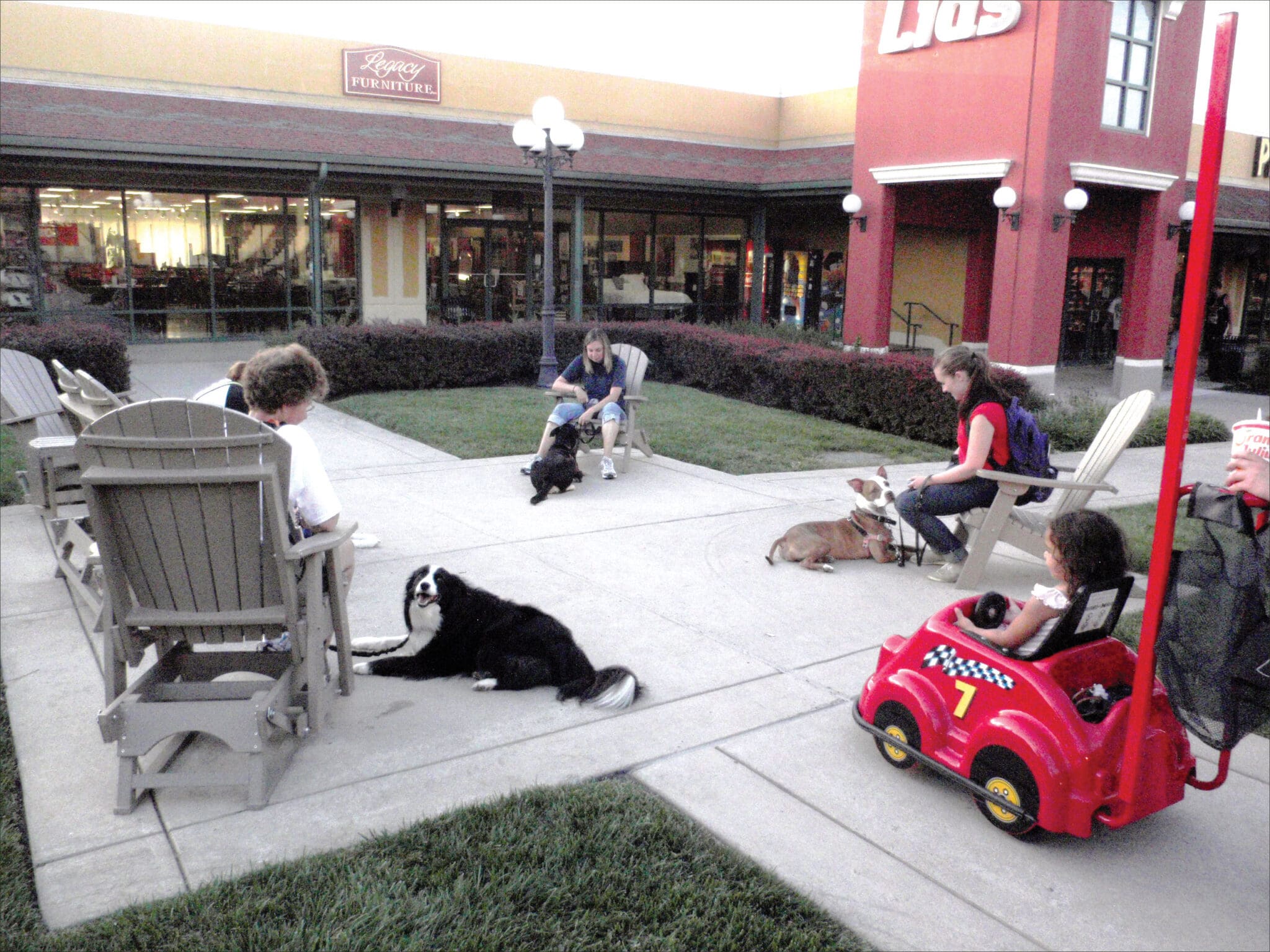
One of the great things about sharing your life with a dog is . . . sharing your life with your dog! True dog lovers always look for opportunities to include their canine companions in their activities. Decisions about recreational selections are often made based on whether the dog can participate or not. A hike in the woods wins over a kayaking trip. An outdoor café gets the nod over a fancy restaurant. Relatives who frown on canines sharing holiday festivities might get passed over in favor of those who welcome your furry family member and even buy her presents.
We applaud those of you who seek to integrate your dogs as fully as possible into your lives. At the same time, we cringe when we see humans in public places allowing their canine pals to commit socially unacceptable acts. Each time this happens, it increases the odds that more public places will be deemed off-limits to dogs, even dogs whose humans are responsible.
There was a time when our society was much more tolerant of “dogs being dogs.” Dogs normally bark at things that are alarming to them, jump on those whom they are glad to see, and eliminate when and where they want to; these are normal behaviors – but not socially acceptable to human society. Our culture’s sensitivity to normal dog behavior (to say nothing of canine behaviors that are louder or larger or more aggressive than average) makes it even more imperative that those who take dogs out in public invest the time and energy to make sure those dogs are model canine citizens. The more crowded, noisy, and busy the environment, the more solid the dog’s behavior should be.
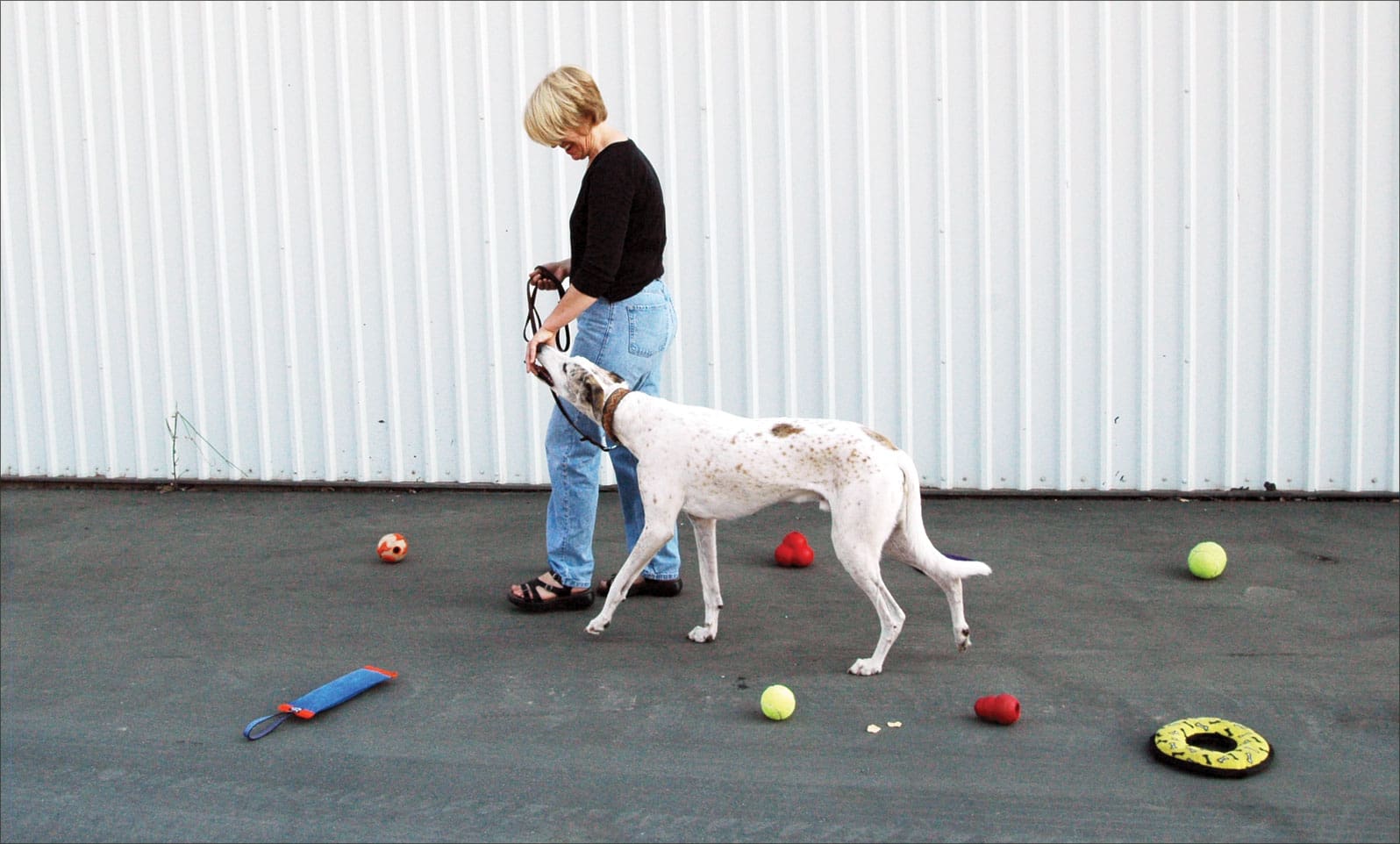
This starts, of course, with basic good-manners training, or what some still call “obedience” training. (We prefer the concept of “good manners,” implying the dog’s voluntary self-control, rather than the phrase “obedience,” which suggests submission to authority.) Dogs can learn good manners from a skilled owner working on her own, but for best results, we recommend well-run group classes (positive reinforcement methods, of course!). Group dog-training classes provide guidance and instruction, additional motivation to do the work, an opportunity to practice in the presence of distractions, a controlled situation for dog-and-human socialization, and a supportive social setting for the human to interact with other dog lovers.
In addition, some trainers offer specialized classes to help your dog learn how to integrate into the real world, including sessions that take place on city streets. These classes may be called things like “Real Life Class,” “Downtown Hound, or “K9 Ice Cream Social,” but what they all have in common are lessons to teach your dog to navigate scary sewer grates and manhole covers, and how to relax and be polite when joggers, skateboards, delivery trucks, and parents with baby strollers go past.
Model k9 citizen skills
The model canine citizen should at least be able to do the following half-dozen behaviors fluently and reliably if he is going to be out in public with you:
Walk politely on-leash. This requires that you spend time teaching your dog good leash manners in low-distraction environments, and gradually add distractions as he proves capable of handling them. He should be able to pass by humans and other dogs without trying to investigate or greet them, and sit or lie down quietly at his human’s side if she stops to chat or window-shop. (See “In Pursuit of a Loose Leash,” October 2012.)
Polite greetings. Fortunately there are still plenty of people out there who love dogs, and there will, inevitably, be people who want to interact with your dog in public. Your dog needs to be well socialized so that he can greet people safely, and well trained to greet people politely. Teach him that a self-controlled sit will elicit attention from strangers. If he tends to jump up after the initial polite greeting takes place, end greetings by turning quickly away and tossing a treat for him to chase away from the person he just met. He’ll start to anticipate the turn-and-treat instead of jumping up for more attention. (See “Keeping Four on the Floor,” May 2008.)
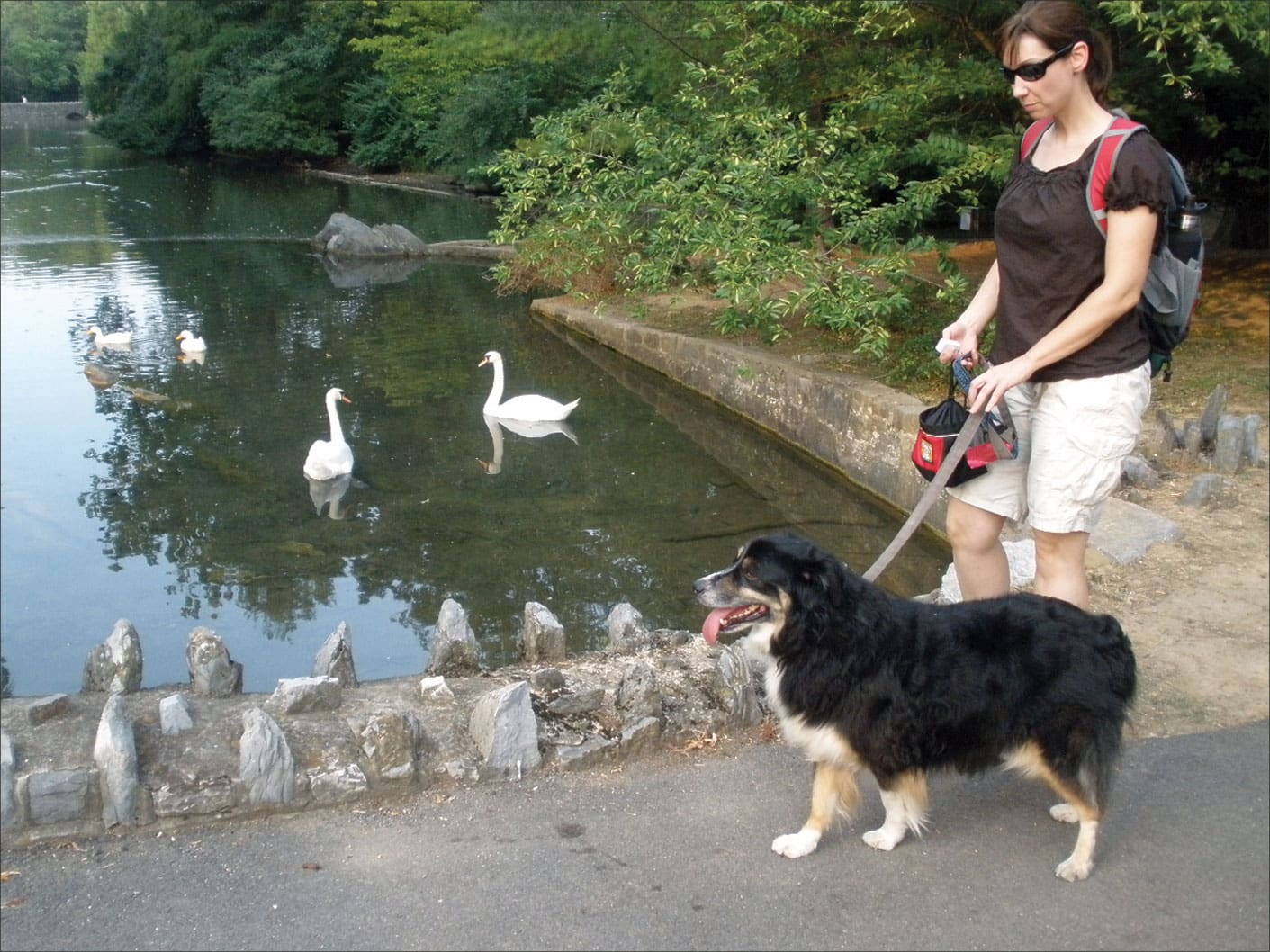
Settle. That outdoor café we mentioned earlier? If you want to take advantage of the ones that allow dogs to frequent the patio, you’d best have a dog who can lie quietly at your feet throughout the meal. You can use a formal “down-stay” or a less formal “settle” or “wait” behavior, but having your dog beg at, or worse, sample food from the table, is unacceptable. (See “Wait a Bit, Stay a While,” May 2001.)
Come. Much of the time your dog is in public he will be on a leash. But if you do have access to off-leash areas or if, heaven forbid, he should somehow slip his collar or otherwise get away from you, you have to be able to get him back. The secret to a solid recall (come) cue is a word that has tons of positive association for him and is never poisoned (i.e., never given a negative association). (See “Rocket Recalls,” September 2012.)
Leave it. Whether you’re walking on a city street or visiting friends in the country, your dog is bound to come across tempting items that you don’t want him to have, whether a bag of fast-food leavings in the gutter, a brazen skunk in the trail, or a baby’s face that’s just begging for a quick kiss! Your cheerful “Leave it” cue will forestall all kinds of trouble. (See “Request for Leave,” August 2008.)
Trade. For those times when the “Leave it” cue didn’t quite come in time, a practiced “Trade” can sometimes save the day. It won’t help much with the skunk, but your dog will promptly relinquish that bag of KFC chicken bones if you’ve taught him a solid “drop” behavior. In a pinch you can offer high-value treats to entice him to drop his prize (or scatter treats on the ground), but you’re safer training it in advance.
With your trained dog at your side, as long as you both refrain from committing other socially inappropriate acts, the two of you will be good ambassadors for the “dogs in public” crowd.

“Oh dear,” you may be thinking to yourself. “What socially inappropriate acts is she talking about? Has my dog committed any? Have I?” We bet most WDJ readers are not likely to be guilty of the most egregious violations. But if you want to do a self-assessment, here’s a checklist of the societal faux pas we find most offensive:
Failure to scoop. It’s hard to believe that anyone today isn’t savvy enough to clean up her dog’s solid waste, but it happens. There is simply no excuse for this. If you happen to get caught out in public without a plastic bag (it can happen), you can always find a trash receptacle with newspaper, plastic, or some other material you can use to scoop.
Peeing on the Pansies. Of course dogs urinate in public, and we don’t expect you to carry around a cup to catch their liquid output. However, we do hope that you are considerate about whereyou allow your dog to pee. Canine urine can cause yellow spots on grass, which your suburban manicured-lawn neighbors are sure to resent. The urine can also kill flowers, stain walls and fences, and leave a strong ammonia odor, especially if your dog pees in the same spot every day.
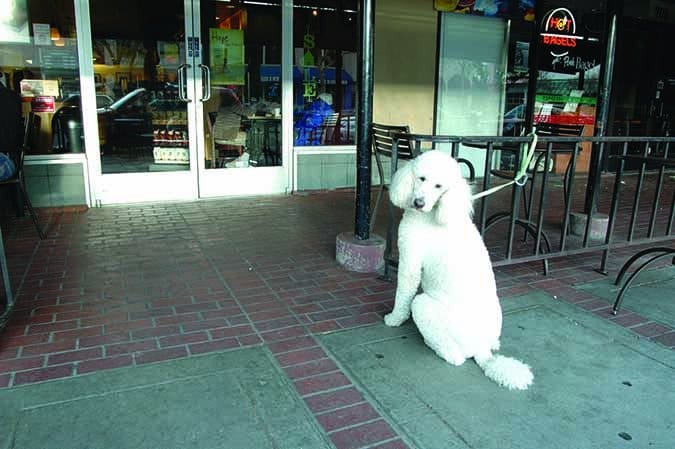
If you’re hiking in the woods, this is not a big deal. But if you walk in groomed parks, suburbs, or cities, please “curb your dog” – that is, direct him to urinate in areas where humans aren’t likely to come in contact with it. Don’t allow him to pee on parking meters, newspaper boxes, bicycle racks, flower boxes, lovingly nurtured gardens, kiddie play equipment, or sports fields.
Kissing Babies. I may be a firm believer that exposure to dog germs is good for baby-human immune systems, but the parent of the child in that approaching stroller may disagree. Unless a child’s parent or caregiver invites your dog to make intimate contact and unless you know for a fact your dog adores children, your dog needs to stay out of the faces of babies and toddlers. Leave the baby-kissing to the politicians.
Tied Up on the street.This one is a major “don’t” – and yet we still see it happening all the time. Do not leave your dog tied up outside the store while you run in “just for a second” to grab something you need. You are putting your dog at huge risk if you do this – of being teased, stolen, injured, frightened – and perhaps feeling the need to bite someone in self-defense. There is no excuse, ever, for leaving your dog unattended in a public place.
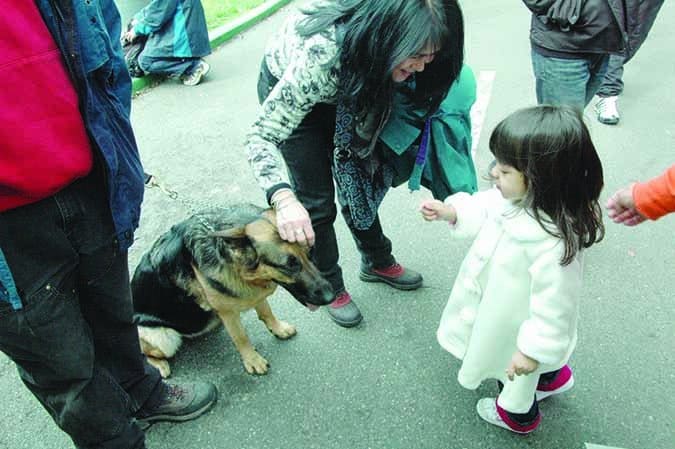
Violating Leash Laws. I know: In some communities there are few, if any, places where your dog can legally run off leash. And off-leash dog parks can be risky to your dog unless they are among the minority of well-monitored public parks or privately owned and run. Still, scoffing at leash laws makes all dog owners look bad, and gives non-dog folks a very legitimate gripe. Bite the bullet, obey the laws, and spend some time cultivating friends with large fenced backyards where you can take your dog, or better yet, rural acreage where you can go hike with your pal.
Dog-Dog Greetings. There are some trainers (I am one of them) who suggest that allowing dogs to greet while on leash is not wise, due to the potential for creating leash-restraint frustration issues. Other trainers, however, help their students teach their dogs how greet other dogs politely on leash.
Whichever you prefer, it is still incumbent on you to make sure the owner of the other dog is agreeable to the dog-dog greeting. “It’s okay, my dog is friendly” is not an appropriate answer when another dog owner asks you not to let your dog approach. Always ask permission; don’t assume you can let your dog greet other dogs.
If your dog does not like to be approached while on leash, check out the DINOS (Dogs In Need Of Space) program and equipment (see www.dogsinneedofspace.com). The Yellow Dog Project is another resource for dogs who need space: see theyellowdogproject.com.
Jumping Up. Nothing turns off people about dogs in public faster than dogs who rudely plant their paws on a person’s clean clothes. If your dog hasn’t learned to greet politely as described above, don’t let him greet at all until he does.
Barking and Biting. This should go without saying, but if your dog goes over threshold in public and barks threateningly or even bites, he shouldn’t be there. Period. If you are doing behavior modification with him, you need to do it in an environment where he can stay below threshold and not threaten the safety of others who have a right to be in public places, too. Even excited barking can be frightening, especially to non-dog people. Work with your dog in places that are less arousing until he is ready for the real world.
If you somewhere without access to quiet, uncrowded places where you can take your dog for walks or exercise, or if you are having difficulty teaching him basic good-manners behaviors, seek the guidance of a qualified positive-behavior professional to help you manage his behavior while you help him learn how to cope with city life.






My dog likes to bite by plying he comes around you and he starts biting for no reason but in the same time he’s plying with you…